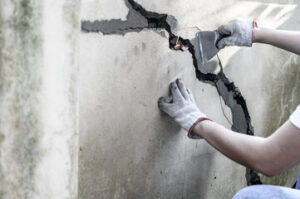Concrete repair is now much faster and less invasive than it used to be. In the past, mudjacking was the only way to raise sunken concrete areas.
A successful concrete repair depends on several factors, including a thorough condition evaluation, determining the cause of deterioration, and selecting appropriate repair methods and materials. This process includes destructive and nondestructive inspections and laboratory chemical and petrographic analysis. Contact Top Coat Technicians for professional help.
The first step in extending concrete life is recognizing when it’s time for repairs. The most common signs include structural movement, cracking, deterioration, and sunken areas.
In most cases, concrete repair requires removing the damaged material without damaging the sound concrete below. The most effective removal method is a light-weight 15 lb. electric or pneumatic chipping hammer that removes only the surface of the damaged concrete to expose the sound concrete below. It’s important to use this type of tool with a chisel or similar tool to break up any re-bar or reinforcement that may be left behind.
The next step is preparing the concrete for the new repair material. The concrete surface should be cleaned thoroughly and saturated with water to ensure it is ready to accept the new material. Concrete surfaces should also be inspected and the voids, blowholes and pits noted. It’s recommended that a specialized concrete repair material be used to fill any open or active voids.
If a repair is to be made with a topical material, it’s important that the concrete is dry and free of any contamination that could prevent the topical materials from adhering or penetrating the surface. Grit blasting or other methods may be necessary to achieve this. If the concrete has corrosion, it’s critical that any reinforcing steel be cleaned to ensure the proper condition for bonding with the new repair material.
When choosing a concrete repair material, its constructability, pumpability, rheology and cure time should be considered. These properties influence the way the repair is installed, such as form-and-pour concrete, pre-placed aggregate, tremie concrete or dry pack repairs. It’s also important to consider how fast the concrete can be placed and set.
For a quick and cost-effective solution to repair sinking or sunken concrete, PolyLevel is an easy-to-use, noninvasive, aesthetically pleasing and long-lasting system. Unlike traditional methods that require injection holes, this system uses a two-part polyurethane polymer that’s injected beneath the sinking concrete through a pencil eraser-sized hole and expands into a structural foam that compacts and lifts the concrete slab to its original position. It’s quick, noninvasive, aesthetically pleasing and lasts up to 20 times longer than traditional methods.
Repairing Cracks
Concrete cracks must be repaired properly to prevent further movement and the loss of the structure. A good quality concrete repair material is required to ensure the cracks remain bonded and not loose. It is important that the conditions are right for concrete placement, including temperature and moisture levels. It is also essential that the correct type of concrete patch or concrete repair product be used for each application. The ideal concrete repair material will have a long life span, be easy to use, and provide superior durability.
The first step in the concrete crack repair process is to clean the crack area and remove any debris from the crack. Leaving any grit or gravel in the crack will inhibit proper adhesion of the repair materials and may cause the repair to back out.
Once the crack has been cleaned, a bonding agent should be applied to the entire length of the crack. A polymer-modified concrete repair material is recommended for this purpose. These products have a high bond strength and are often more durable than portland cement. They are also designed to resist oil and salts, and will typically withstand freezing temperatures.
For smaller cracks that are 1/8-inch wide or narrower, an epoxy or latex patching material can be used. These products have good adhesive properties and can be easily applied to the surface of the existing concrete.
For larger, more serious cracks, a method known as drilling and plugging is used. This is a cost-effective solution that is suitable for cracks that are running in straight lines. In this procedure, a hole the length of the crack is drilled and then grout is passed down the hole. This creates a grout “key” that locks the crack and reduces further movement of the concrete sections.
If the cracks are running vertically, they can be stabilized by using a chemical epoxy injection. This technique is expensive and requires a skilled contractor. It is not a viable solution for active cracks that are moving, however. This type of repair should be considered a short-term fix and should be followed by resurfacing the concrete to improve its appearance.
Filling Holes
Concrete repair can include patching small holes, repairing surface wear and resurfacing or levelling sagging concrete slabs. It can also involve re-colking or sealing joints and repairing spalling. It is important to address any problems with concrete as soon as possible to prevent further deterioration and avoid serious structural damage.
Thoroughly clean the area to be repaired by sweeping or vacuuming debris from the area and wiping it down with a damp rag. If the hole is deep, use a cold chisel to break up and remove any loose concrete. Then dig out the damaged section and flush it thoroughly with water from a hose.
The right mix of material is essential for the correct repair to be made. The material must be compatible with the existing concrete, able to be placed using the intended installation procedure and capable of performing the desired function without significant loss of strength, stiffness or durability. A good mix will also be easy to work with – it should flow easily and have a desirable slump. Other important properties are pumpability, rheology and cure time.
A concrete repair mix will also vary depending on the type of repair to be carried out. For example, if the structure is to be returned to service quickly, it will be important for the repair mix to have a low water content and rapid set. This will reduce the amount of mixing required and shorten the curing time, allowing the structure to be put back into service sooner.
There are many different products available for concrete repair including caulks, vinyl concrete patches and self-leveling concrete sealants. However, they will not give the same results as professionally mixed concrete. In addition, they may not last as long and they are not ideal for large areas of damaged concrete.
For example, PolyLevel is an innovative product that uses a two-part polyurethane to fill voids and lift sunken concrete. It is injected underneath the concrete through a pencil eraser-sized hole and expands to create a stable structural foam. This solution fixes the underlying problem of soil not being compacted properly and is quick, noninvasive and aesthetically appealing.
Repairing Sunken Areas
While it may seem tempting to use quick fixes like filling in cracks or using concrete patch mixes to repair sunken areas, these methods are often only temporary bandages that don’t address the underlying cause of the problem. For long-lasting results, it’s important to hire well trained and experienced concrete repair contractors that have the expertise to properly assess the damage and select the appropriate repair method.
During the concrete repair process, all existing concrete must be cleaned thoroughly of any dirt, debris or oil. This must be done before applying the patch mix or new concrete. Often this is done by brushing and scrubbing with water or a power washer. It’s also important that the area is completely dry prior to placing the concrete. Contractors don’t have the time to wait for Mother Nature to do her job so they will usually use concrete sprayers or power nozzle attachments on their equipment to speed up the drying process.
The next step is to apply a bond coat to the damaged surface. This must be done so that the repair material bonds to the existing concrete and does not loosen or fall off during the curing process. Several different types of bond coats are available, including mortar mixes with portland cement, latex emulsions mixed with portland cement or epoxy resins. Several hardware stores sell liquid chemical additives that can be added to concrete to help it bond to itself and old work.
Once the bond coat is applied and the concrete mix is placed, it’s necessary to use a vibration machine to compact the concrete. This will ensure a dense, smooth finish that is strong and durable. It’s also important to pay attention to concrete consolidation around dowel bars and along the patch perimeter. This will prevent honeycombing in the concrete that reduces its strength and durability.
The increased concrete repair activities due to concrete durability failures have escalating impacts on the environment and society worldwide. They deplete natural resources and generate massive amounts of waste and carbon emissions. Engineers have a role to play in developing eco-efficient repair systems that attain specified performance levels at lower cost and environmental impact.
